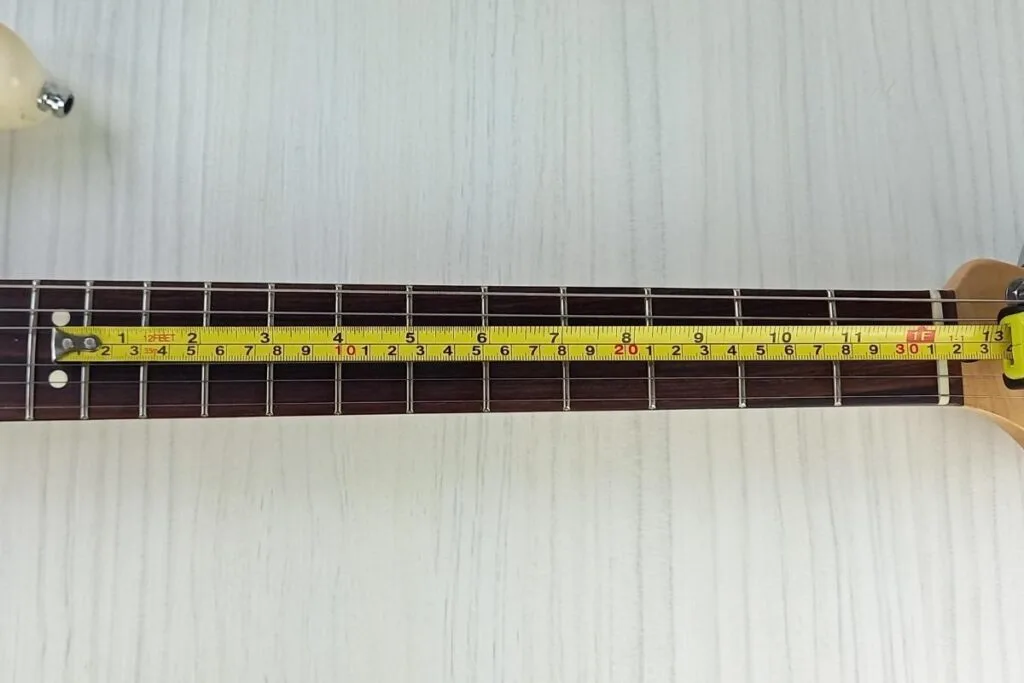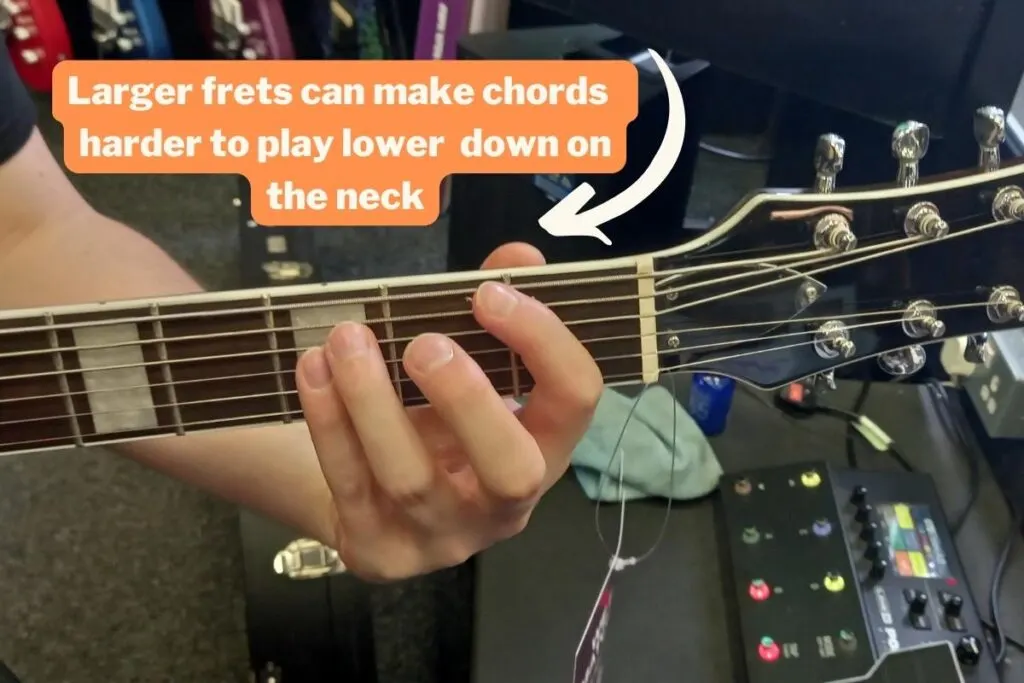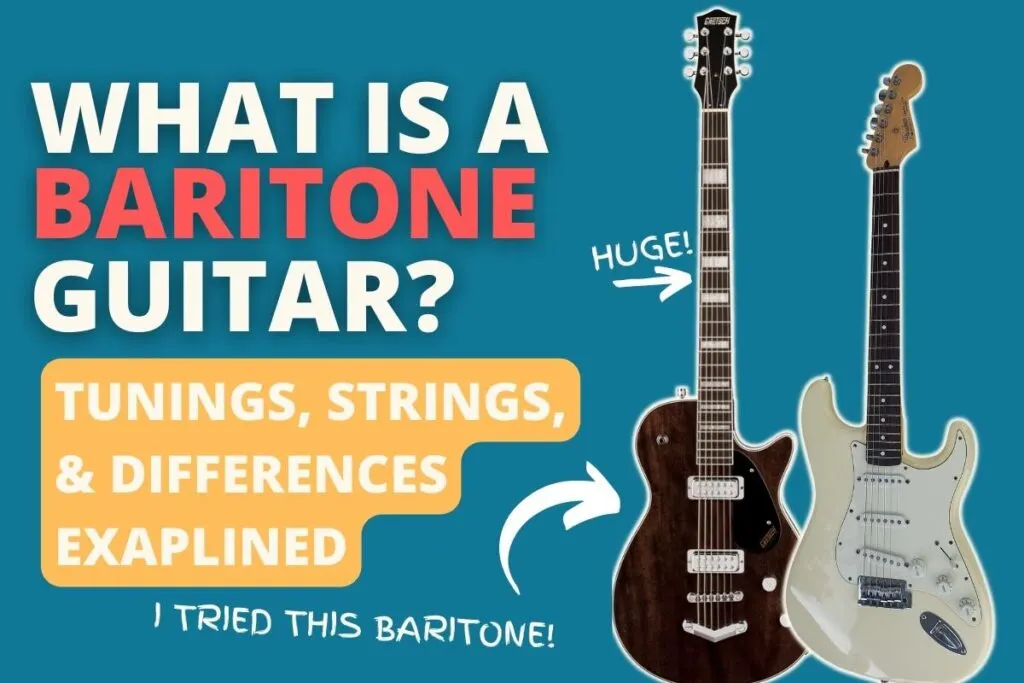Baritone guitars are often overshadowed by their regular-sized counterparts, and as such are overlooked by guitarists. They’re often seen as a half-way house between a normal guitar and a bass, and as such get forgotten about by mainstream music. But its low tuning and high sustain makes it a powerhouse for genres such as hard-rock and metal.
For this article, I went to my local guitar shop and tried out a baritone guitar so that I could compare it to a regular guitar. I’ve included my thoughts, and a video of what a baritone sounds like, further down.

So, let’s take a look at the misunderstood baritone guitar and learn about what makes them different, what strings they use, their tuning, and how they’re used in music.
Affiliate disclaimer: This page contains affiliate links for products that I’ve tried and tested. As an Amazon Associate I earn from qualifying purchases at no additional cost to you. Learn more here.
What makes a baritone guitar different?
There are two main qualities that differentiate a baritone from a standard guitar: the scale length and body size. Both of which are closely related and give baritones their signature, deep sound.
Firstly, the scale length differs from a standard guitar. The scale length is the measurement between a guitar’s bridge and nut. The scale length on most guitars is between 24-26 inches, whereas baritone guitars are generally between 27-30 inches.

To give some perspective, bass guitars have a scale length of around 34″, meaning a baritone will sound deeper than a standard guitar, but less deep than a bass guitar.
The longer scale length also means that the frets are larger and spaced further apart, which can be difficult for beginners or guitarists with smaller hands.

Secondly, baritone guitars have a larger neck and body than standard-sized guitars. This is a direct result of needing more space between the bridge and nut. As such, baritones are often a bit heavier, although they’re not as large or heavy as a bass guitar. It also means that frets are spaced a bit further apart than usual, meaning that a baritone may be more difficult to play at first.
What strings do baritone guitars use?
Baritone guitars use slightly thicker strings than normal-sized guitars due to both the longer scale length and lower tuning. Baritone strings are thicker, providing a fuller, darker tone that sustains longer on the frets. The thickness of the baritone strings allows them to be tuned to lower notes without becoming floppy and losing resonance.
As with any other guitar string, baritone guitar strings are an essential component for both playability and tone. Some guitarists prefer lighter gauge strings which are easier to bend, whereas others prefer thicker strings which are more difficult to play but sustain longer with a fuller sound. It’s all down to personal choice.
For both the acoustic and electric baritone guitars, thickness (called “gauge”) starts at 0.013 inches for the high “E” and .062 inches for the low “E” string. To put it in perspective, the average string gauge for normal-sized guitars is 0.010 inches for the high “E” and 0.042 inches for the low “E”.
If you’re just getting started with playing baritone guitar, I’d recommend using a lighter gauge string to make it easier on your fingers. Check out these Ernie Ball Baritone 6 String Baritone (13-72) strings on Amazon.
Baritone guitar tuning
The key characteristic of a baritone guitar is its ability to play deep, low-sounding notes. Therefore, baritone guitars are tuned significantly lower than a standard guitar.
The most commonly used tuning for a baritone guitar is B-E-A-D-F#-b, from lowest to highest string. Each string is a whole five steps lower than a standard guitar’s tuning (E-A-D-G-B-e).
Of course, that’s not the only tuning available for the baritone guitar. In fact, the thicker strings lend themselves to drastic pitch drops without losing their sustain or resonation. Baritone guitars can be tuned down to A (A-D-G-C-E-a) or even tuned up to C (C-F-B♭-E♭-G-c). However, “B” and “A” tunings are by far the most popular, with the former being the “go-to.”
Playing in a different tuning can be a bit daunting if you’re not used to it. But, it’s quite simple once you’ve tried it! The chord patterns will still be the same, they’ll just play different chords. For example, playing an “A” chord shape on a standard guitar in standard tuning will make an “A” chord sound. Playing an “A” chord shape on a baritone guitar in “B” tuning will make an “E” chord. In this tuning chords and notes will always be five steps (or “semi-tones”) lower than in standard tuning.
My experience playing a baritone guitar
I went to my local guitar shop and tried out a baritone guitar for myself – namely, the Gretsch G5260. This guitar has a 29.75 inch scale length, and I could really feel it! The frets felt so much larger, and the neck so much longer. It took a while to get used to, and I think it would be a difficult guitar for a beginner or a smaller player.
This guitar was tuned to “B” and used 0.014 inch gauge strings. The longer scale length and higher string tension made the low sounding notes ring out clearly. Much more so than tuning down a regular guitar. This made the guitar feel like it had a lot of “weight” behind it, and it sounded surprisingly “snappy” and bright. That being said, the increased string tension made bending and vibrato a lot harder compared to a regular guitar. Also, my hands were worn out after a while of stretching them further than usual!
Here’s a clip of what it sounds like.
Ultimately, I’d recommend trying one out for yourself to see if it’s something that you’d like to play. Personally, I don’t feel the need to buy one at the moment. If I need to tune down, then I will just use higher gauge strings to increase the string tension, for the time being.
What genres use baritone guitars?
Over the years, musicians from across all genres of music have used the baritone guitar to add variation to their albums. Whether as a way to create harmonies supporting the standard guitar, or stand out on its own.
From a technical point of view, the baritone is low enough to stand out from the general mix without clashing with the guitar and bass. It’s a great choice for musicians looking to add depth and fullness to a song.
The baritone was featured in countless surf rock songs as the genre’s popularity grew in the 1960s. Composers have used it to create iconic scores for films and TV shows, like Ennio Morricone in the spaghetti western “Once Upon A Time In The West” and David Lynch in “Twin Peaks.”
But, baritones have a wider appeal than just surf rock and film scores.
Baritone guitars are well used in the metal genre, which is for using dropped tunings to create a darker sound. Some notable metal musicians include John Petrucci of “Dream Theatre” and Robb Flynn of “Machine Head”.
But they’re not just for metal. Rock guitarists like Aerosmith’s Joe Perry and Dave Matthews have wielded baritones on ‘Back In The Saddle’ and ‘The Space Between,’ respectively.
The baritone has even made its way into the pop music scene. Hits like ‘If You Were There, Beware’ by the Artic Monkeys and ‘Take Me To Church’ from Hozier both feature the baritone.
Although the baritone is quite popular in western music, it’s still unconventional to play a baritone exclusively. It’s more of a tool that’s used in a specific way than a “go-to” guitar. That being said – there are no rules in music! If you want to play a baritone as your only guitar, then go ahead!
Popular Baritone Guitar Brands
Danelectro was the first major brand to set the trend of the baritone guitar back in the 1950s & 60s. Fender caught on and joined the party in the 1960s. Those guitars were not as advanced as the baritones progressive musicians prefer today. Still, the simplicity of the baritone then left an everlasting impression when it was famously used in the surf rock boom.
Some companies still manufacture new baritones with classical styles and sound like Gretsch and Burns London. Other manufacturers have focused their attention on the needs and desires of progressive guitar players in the metal and rock genres, as most guitarists with extraordinary skill and technique gravitate towards the genres where they can showcase it.
Manufacturers like Music man, Schecter, and Ibanez have familiarized themselves with the trends and developments of various guitar aficionados. They have gone to great lengths to build custom baritones to keep the particular interest alive and well.
Conversely, popular guitar brands like Taylor, Martin, and Santa Cruz have also addressed the interest and developed acoustic baritones.
Still, the baritone is a lot less common than normal-sized guitars and doesn’t have as wide of a selection available.
Popular baritone guitar models
Although there’s not a massive selection of baritones available, there are still a few popular models available that stand out. Namely the, PRS SE 277, Gretsch G5260Squier Paranormal Cabronita Telecaster (Baritone), and the Ibanez RGIB21.
Conclusion
Baritone guitars are not as versatile as standard guitars, but they offer a dark rich tone with lower notations that standard guitars cannot imitate. Although baritone guitars cannot be considered a replacement for the standard guitar, they have redeeming qualities that make them a worthy addition to any guitarist’s collection.
If you’re a beginner guitarist, or on the smaller side, I’d recommend holding off on buying a baritone just yet. If your heart is set on it, then I’d recommend going into your local guitar store and trying one before you buy!


Conor is a music producer, multi-instrumentalist, and all-round enthusiast from the UK with over 15 years of experience. He’s the founder and sole-content creator for the roundtable audio blog and YouTube channel.
